ISSN ONLINE(2319-8753)PRINT(2347-6710)
ISSN ONLINE(2319-8753)PRINT(2347-6710)
Anup T J1, Vilas Watwe2
|
| Related article at Pubmed, Scholar Google |
Visit for more related articles at International Journal of Innovative Research in Science, Engineering and Technology
Environmental concern and availability of petroleum fuels have caused interests in the search for alternate fuels for internal combustion engines. Conversion of waste to energy is one of the recent trends in minimizing not only the waste disposal but also could be used as an alternate fuel for internal combustion engines. Waste plastics are indispensable materials in the modern world and application in the industrial field is continually increasing. In this context, waste plastics are currently receiving renewed interest. In the present paper waste plastic pyrolysis oil, waste plastic pyrolysis oil of petrol grade and diesel grade and its blend with diesel and petrol respectively has been introduced as an alternative fuel. In this study, a review of research papers on various operating parameters have been prepared for better understanding of operating conditions and constrains for waste plastic pyrolysis oil of both grade fuel and its blends fuelled in compression and spark ignition engine.
Keywords |
| alternative fuel, diesel engine, petrol engine, engine emission |
I. INTRODUCTION |
| Diesel engines and petrol engines are the most efficient prime movers, from the point of view of protecting global environment and concerns for long-term energy security it becomes necessary to develop alternative fuels with properties comparable to petroleum based fuels. Unlike rest of the world, India’s demand for diesel fuels is roughly six times that of gasoline hence seeking alternative to mineral diesel is a natural choice. Alternative fuels should be easily available at low cost, be environment friendly and fulfilEnergy security needs without sacrificing engine’s operational performance. Waste to energy is the recent trend in the selection of alternate fuels1. Fuels like alcohol, biodiesel, liquid fuel from plastics etc. are some of the alternative fuels for the internal combustion engines. Utilization of biomass as alternative fuel for compression ignition engine has a great scope especially in developing and undeveloped countries. |
| Plastics have become an indispensable part in today’s world, due to their lightweight, durability, energy efficiency, coupled with a faster rate of production and design flexibility, these plastics are employed in entire gamut of industrial and domestic areas hence plastics have become essential materials and their applications in the industrial field are continually increasing. At the same time, waste plastics have created a very serious environmental challenge because of their huge quantities and their disposal problems2. Instead of biodegradation, plastics waste goes through photo-degradation and turns into plastic dusts which can enter in the food chain and can cause complex health issues to earth habitants, through the thermal treatment on the waste plastic the fuel can be derive3, by adopting the chemical process such as Pyrolysis can be used to safely convert waste plastics into hydrocarbon fuels that can be used for transportation4. |
II. LITERATURE SURVEY |
| M.fAli8reported that the high yields of liquid fuels in the boiling range 100–480°C and gases were obtained along with a small amount of heavy oils and insoluble material such as gums and coke. The results obtained on the co-processing of polypropylene with coal and petroleum residues are very encouraging as this method appears to be quite feasible to convert plastic materials into liquefied coal products and to upgrade the petroleum residues and waste plastics. Miskolczi4 Investigated the pyrolysis of real waste plastics (high-density polyethylene and polypropylene) in a pilot scale horizontal tube reactor at 520 °C temperature in the presence and absence of ZSM-5 catalyst. It was found that the yields of gases, gasoline and light oil could be increased in the presence of catalyst. They also concluded that the plastic wastes could be converted into gasoline and light oil with yields of 20–48% and 17–36% respectively depending on the used parameters. F murfyk3 from the recent literature, it is evident that the process of converting waste plastic to reusable oil is a current research topic. Hence in this paper, preparation of blends of diesel with varying proportions of waste plastic oil produced from the thermal pyrolysis and the analysis of viscosity and density of these blends is presented. The feasibility of the waste plastic oils derived from PVC plastics as an alternate fuel for transportation is also checked by conducting performance test on a single cylinder Kirlosker diesel engine equipped with electrical loading at 50% of the engine maximum load i.e., at 3.7 kW. |
III. WASTE PLASTIC PYROLYSIS OIL |
| Pyrolysis is the chemical decomposition of organic substances by heating the word is originally coined from the Greekderived elements pyro "fire" and lysys "decomposition". Pyrolysis is usually the first chemical reaction that occurs in the burning of many solid organic fuels, cloth, like wood, and paper, and also of some kinds of plastic. Anhydrous Pyrolysis process can also be used to produce liquid fuel similar to diesel from plastic waste. Pyrolysis technology is thermal degradation process in the absence of oxygen. Plastic waste is treated in a cylindrical reactor at temperature of 300ºC – 350ºC. The plastic waste is gently cracked by adding catalyst and the gases are condensed in a series of condensers to give a low sulphur content distillate. All this happens continuously to convert the waste plastics into fuel that can be used for generators. The catalyst used in this system will prevent formation of all the dioxins and Furans (Benzene ring). All the gases from this process are treated before it is let out in atmosphere. The flue gas is treated through scrubbers and water/ chemical treatment for neutralization. The non-condensable gas goes through water before it is used for burning. Since the Plastics waste is processed about 300ºC - 350ºC and there is no oxygen in the processing reactor, most of the toxics are burnt. However, the gas can be used in dual fuel diesel-generator set for generation of electricity. |
IV. DISTILLATION |
| This process applied for petrol and diesel grade fuel production process. Waste plastic to fuel was use for further distillation process and making petrol and diesel grade fuel. Distillation column was use for distillation process. Distillation process set up different columns with different temperature profile like low boiling point fuel to high boiling point fuel. Petrol grade fuel collected from 1st fractional column and temperature range was 90°C to 130°C. Diesel grade fuel collected from 2nd fractional column and temperature range was 250°C to 285°C. In distillation process, 2nd grade fuel was diesel fuel and diesel fuel density 0.80 g/ml. This fuel hydrocarbon compound also heavier and this fuel are not igniting. Collected diesel grade fuel percentage was 29% and rest of all other fractional fuel percentage was 71% including light gas also. Fractional distillation process was also generating some light gases. Light gas cleaning procedure also same above procedure. Plastic pyrolysis fuel to different fuel by using fractional distillation column used for heat applied with different column temperature wise and fuel break down into shorter into longer chain wise and come out into different fraction column then collected into different separate container for grade wise. |
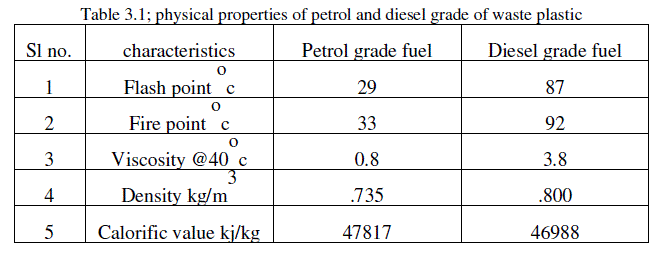 |
V. PERFORMANCE CHARACTERISTICS |
| The various performance parameters such as brake thermal efficiency, brake Specific fuel consumption and exhaust gas temperature under study is summarized as follows. |
| BRAKE THERMAL EFFICIENCY: The experimental study on a single cylinder, four-stroke, air cooled DI diesel engine and air-cooled spark ignition engine with waste plastic oil, At full load, the efficiency is higher for diesel and petrol fuel. This is due to the fact that at full load, the exhaust gas temperature and the heat release rate are marginally higher for waste plastic oil compared to diesel and petrol. |
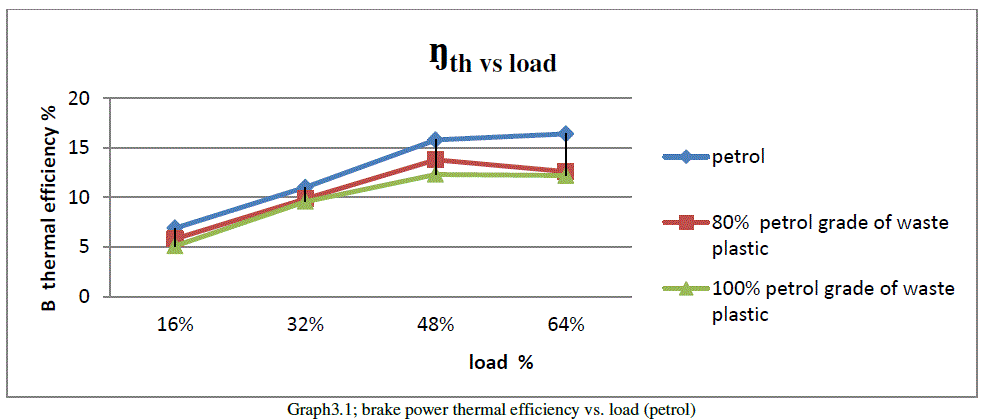 . . |
| Graph3.1shows thatan experimental study on waste plastic oil and petrol fuel blends in spark ignition engine proved that the thermal efficiency is 16.4% at full load for petrol.It is observed that the engine fuelled WPO100 and WPO80 of petrol grade gives brake thermal efficiency of 12.6% and 12.2% respectively at full load. |
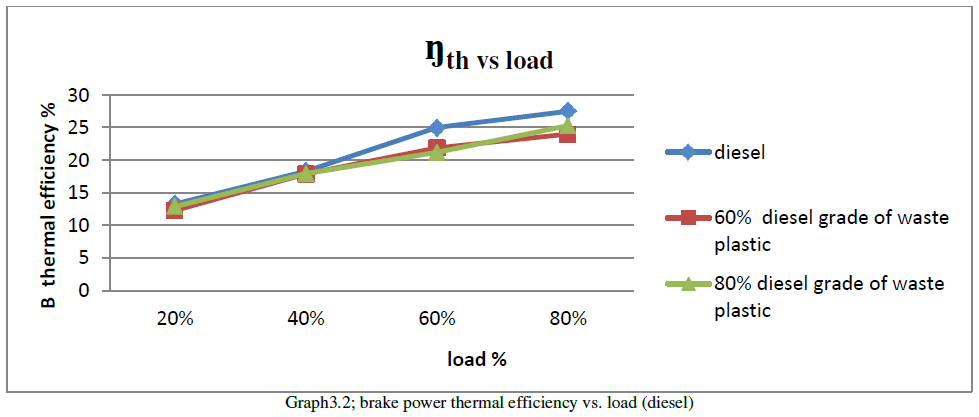 |
| Graph3.1shows that an experimental study on waste plastic oil and diesel fuel blends in compression ignition engine6 proved that the thermal efficiency is 27.5% at full load. It is observed that the engine fuelled WPO60 and WPO80 of diesel grade gives brake thermal efficiency of 24% and 25.3% respectively at full load. The total heat release for each WPO-DF blends is lesser than diesel. Hence, the brake thermal efficiency is lower for the WPO-DF and WPO-PF blends than diesel and petrol respectively. Because of the changes in composition, viscosity, density and calorific value of WPO-DF blends, the brake thermal efficiencies of WPO-DF and WPO-PF blends are low particularly at full load. BRAKE SPECIFIC FUEL CONSUMPTION: Brake specific fuel consumption measures how efficiently an engine is using the fuel supplied to produce work. It is inversely proportional to thermal efficiency. |
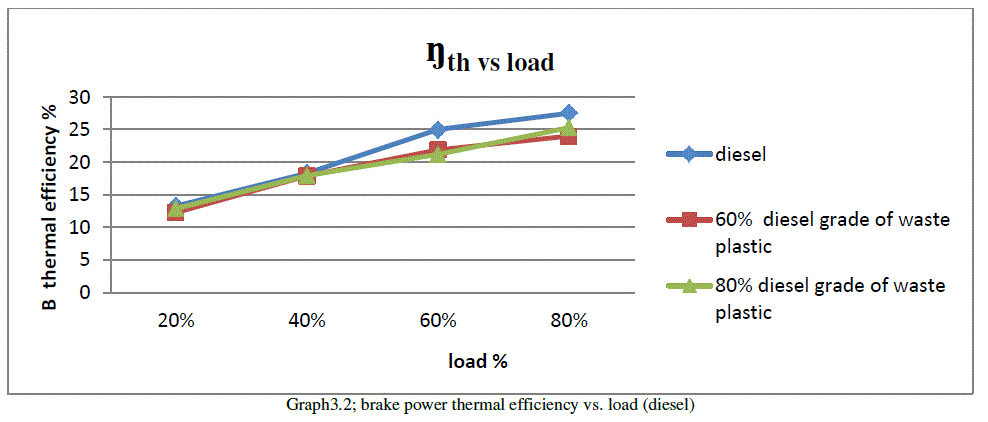 |
| Graph 3.3 shows that the brake specific fuel consumption for the 80% and 100% petrol grade fuel of waste plastic oil varies from 01.28kW to 0.59 kW at full load and 1.474 KW to 0.598KW for petrol engine, As the load increases, BSFC decreases for all fuel blends. |
 |
| Graph 3.4 shows that at full load, WPPO blends show the specific fuel consumption higher than the diesel. The main reason for this could be that percentage increase in fuel required to operate the engine is less than the percentage increase in brake power due to relatively less portion of the heat losses at higher loads9. |
V. EMISSION CHARACTERISTICS |
| Internal Combustion engine emissions have been major contributor to air pollution regulated pollutants are carbon monoxide (CO), NOx, and unburned fuel or partly oxidized HC. Which are summarized as follows. UNBURNED HYDROCARBON:Unburned hydrocarbon emissions consist of fuel that is incompletely burned. The term hydrocarbon means organic compounds in the gaseous state, solid hydrocarbons are part of the particulate matter. Typically, unburned hydrocarbons are a serious problem at light loads in CI engines10. At light loads the fuel is less to impinge on surfaces, but because of poor fuel distribution, large amounts of excess air and low exhaust temperature, lean fuel–air mixture regions may survive to escape into exhaust. |
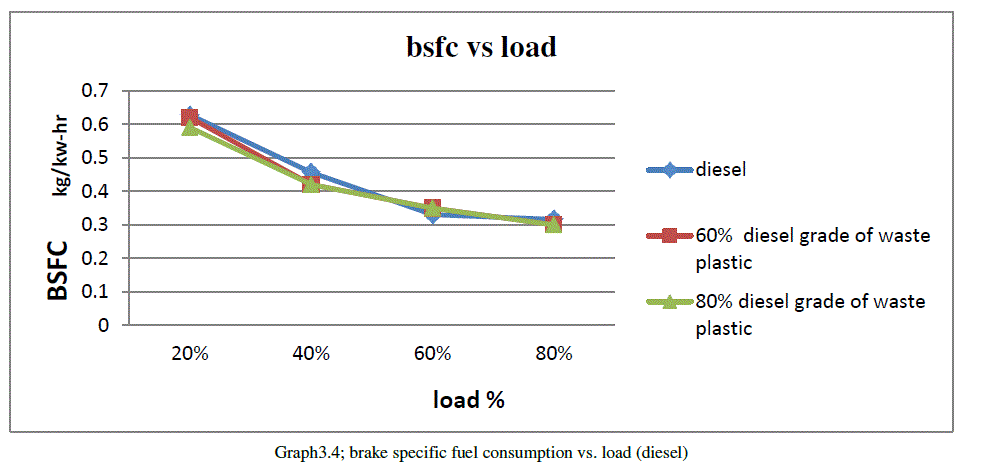 |
| Graph 3.5 shows that Petrol grade fuel of waste plastic oil shows that, unburned hydrocarbon varies from 71 ppm at no load to 93 ppm at full load for different blends. At lighter loads due to charge homogeneity and higher oxygen availability, the unburned hydrocarbon level is less in the case of waste plastic oil, whereas at higher load ranges due to higher quantity of fuel admission, unburned hydrocarbon increases. |
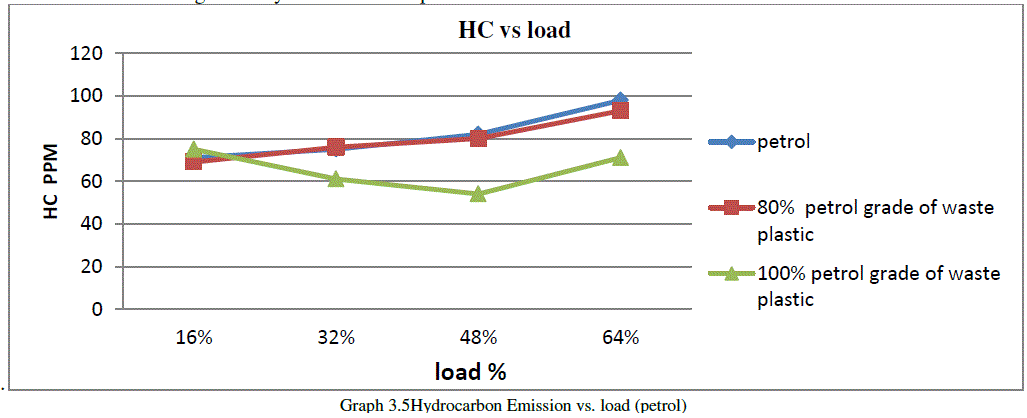 |
| Graph 3.6 shows that an experimental study on diesel grade fuel of waste plastic oil shows that, unburned hydrocarbon varies from 36 ppm at low load to 58 ppm at full load for different blends, and Graph It is noticed that the concentration of the hydrocarbon of waste plastic oil is little higher than diesel; the reason behind increased unburned hydrocarbon in waste plastic oil may be due to higher fumigation rate and non-availability of oxygen relative to diesel. |
| NITROGEN OXIDES (NOX) EMISSION:andFuels with ring structure tend to have a higher adiabatic flame temperature which results in higher heat release rate11.Due to higher heat release rate, the in-cylinder temperature would also increase with increase in WPO concentration in the WPO-DF and WPO-PF blend this is the reason for higher NOx formation in the case of WPO-DF. |
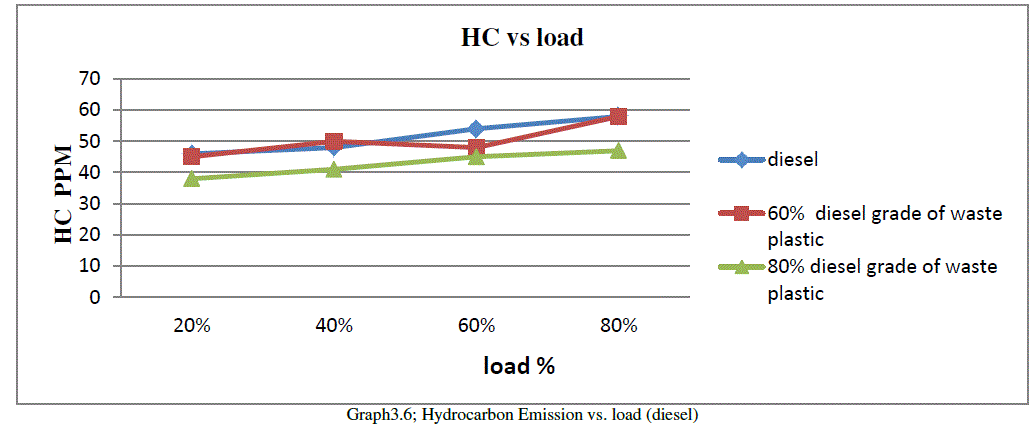 |
| Graph 3.7 shows that Petrol grade fuel of waste plastic oil shows that, nitrogen oxides varies from 16 ppm at no load to 149 ppm at full load for different blends. The reason for the increased NOx is higher heat release rate in the case of WPO. WPO is a higher aromatic content fuel with ring structure. |
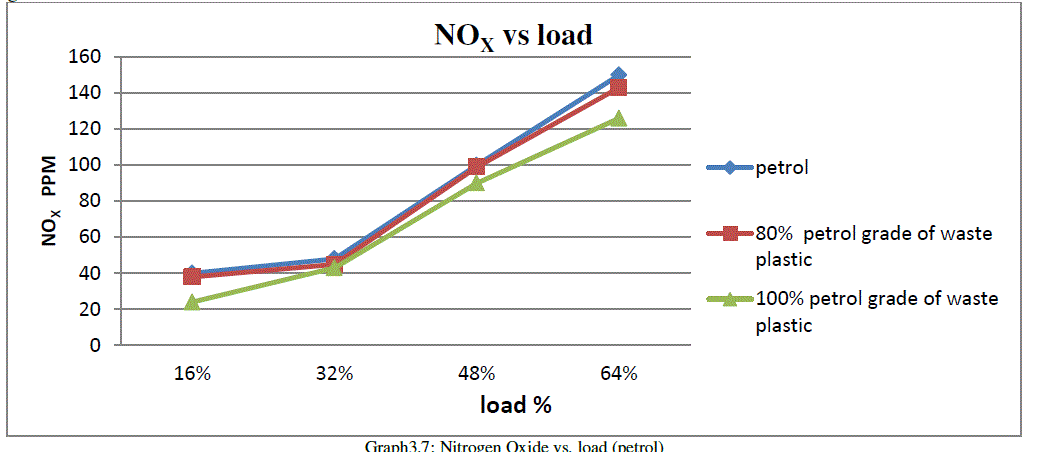 |
| Graph3.8 shows that an experimental study on waste plastic oil and diesel fuel blends in compression ignition engine indicate that7, An experimental study on diesel grade fuel of waste plastic oil shows that, nitrogen oxides varies from 114 ppm at low load to 1261 ppm at full load for different blends. |
| CARBON MONO-OXIDE (CO) AND CO2 EMISSION: Generally, CI engine operates with lean mixtures and hence the CO emission would be low. CO emission is toxic and must be controlled. It is an intermediate product in the combustion of a hydrocarbon fuel, so its emission results from incomplete combustion. The experiment performed on a single cylinder, four-stroke, air cooled DI diesel engine and air cooled petrol engine with waste plastic oil5. |
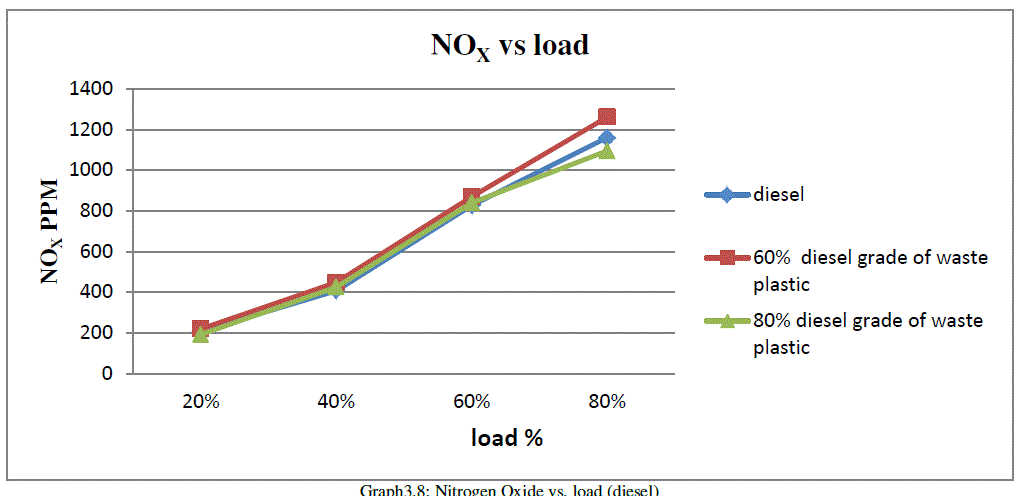 |
| Petrol grade fuel of waste plastic oil shows that, CO2varies from 2.10 % vol. at no load to 4.10% vol. at full load for different blends,and petrol grade fuel of waste plastic oil shows that, CO varies from 3.03%vol. at no load to 3.3 % vol. at full load for different blends. |
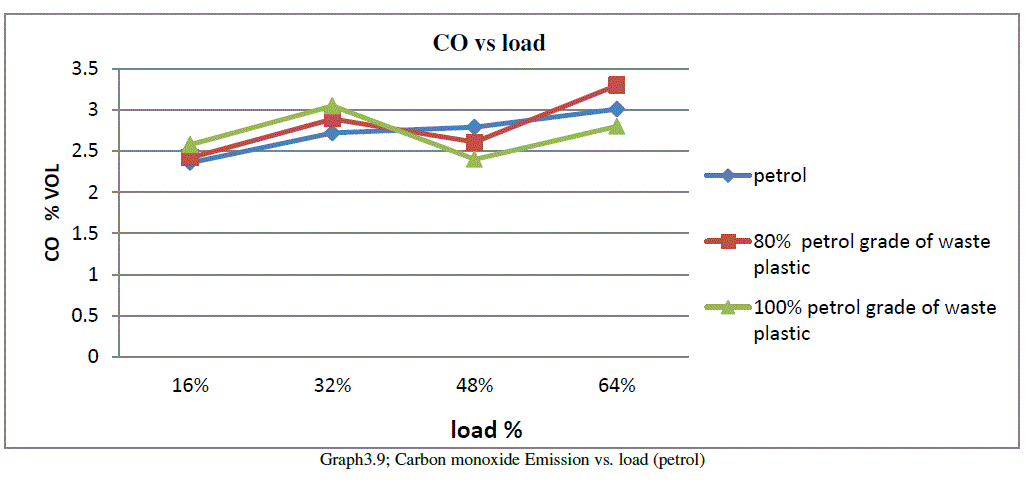 |
| Graph shows that an experimental study on diesel grade fuel of waste plastic oil shows that, CO2varies from 2.40% vol. at lowloadto7.60 % vol. at full load for different blends,An experimental study on diesel grade fuel of waste plastic oil shows that, CO varies from 0.08% vol. at low load to 0.10 % vol. at full load for different blends.Here the CO emission of waste plastic oil is higher than diesel. The reason behind increased CO emission is incomplete combustion due to reduce in cylinder temperatures. |
VI. CONCLUSION |
| • Petrol Engine was able to run with 100% waste plastic oil. |
| • Engine fuelled with waste plastic pyrolysis oil exhibits higher thermal efficiency up to 50% of the rated power for petrol engine. |
| • Engine fuelled with waste plastic pyrolysis oil exhibits higher thermal efficiency up to 75% of the rated power for diesel engine. |
| • The exhaust gas temperature for waste plastic pyrolysis oil is higher than diesel and petrol for engine performance. |
| • Unburned hydrocarbon emission of waste plastic pyrolysis oil is less than that of diesel and petrol; for the different load. |
| • The NOx emission in waste plastic oil varies from 55 ppm to 91 ppm for petrol grade fuel of plastic oil, and for diesel grade fuel of plastic oil varies from 192 ppm to 1268 ppm. |
| • CO emission increased by 5% in waste plastic oil compared to diesel operation. |
| • The CO2 concentration increases with increase in load, due to incomplete combustion. |
References |
|